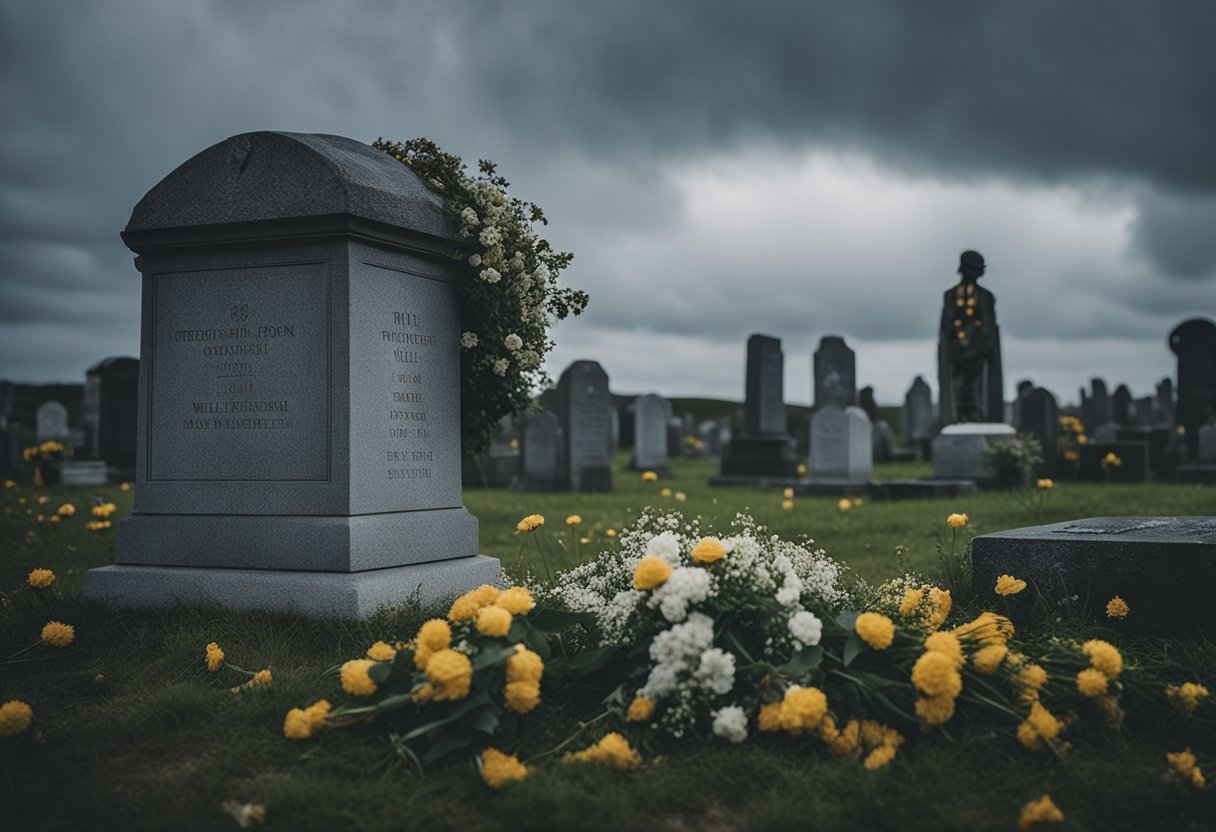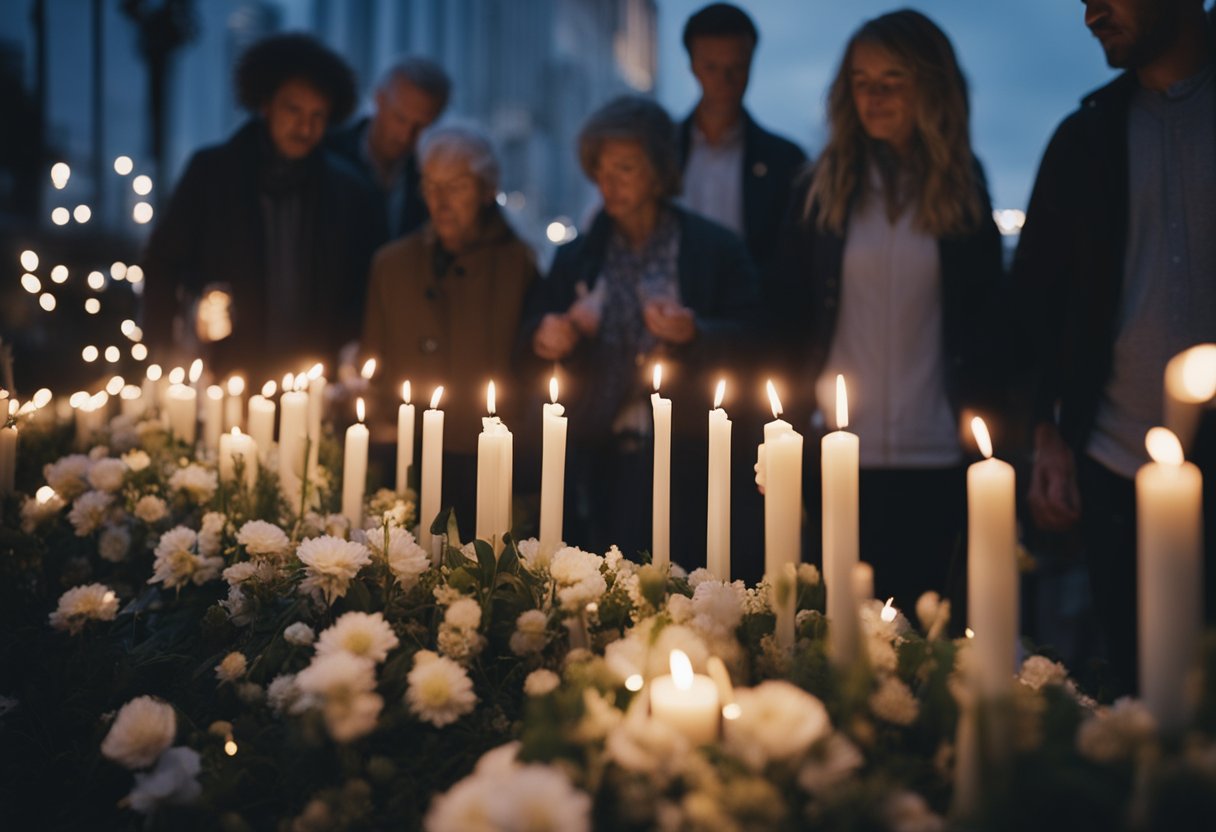The Language of Loss: Comparative Insights on Grieving Expressions Across Cultures

Updated On: April 22, 2024 by Eman Sameh
The language of loss is a language spoken in the heartbreak and memories of every culture. In Ireland, as in many other places, it weaves through music, literature, and spoken eulogies, creating a tapestry encompassing individual and communal experiences. Our understanding of loss is broadened by considering the varied expressions of bereavement across different societies.
While the Irish may be known for their wakes and poignant ballads, other cultures contribute their own unique mourning practices and philosophical approaches to the concept of death. These global perspectives shape how we come to terms with the finality of losing a loved one and the intricate language of sadness that follows.

As we navigate our shared experiences of mourning, the influence of societal norms and the psychological layers of grief become apparent. The language can unite communities or isolate individuals depending on prevailing cultural attitudes and expectations. Despite geographic and social differences, the expressions of loss often share common threads, rituals, traditions, and customs that serve as an outlet for emotional pain and a means to honour the deceased. Digging into grief’s many expressions, from the professional approaches used in bereavement support to the burgeoning impact of technology, provides us with significant insights into this complex human condition.
The Language of Loss: Cultural Perspective
Grief is a profound human experience, widely varied yet universally felt. Examining the cultural contexts that shape grief expressions enriches our understanding.
Cross-Cultural Expressions
Within the vast array of world cultures, individuals navigate the journey of loss in deeply personal yet culturally influenced ways. The Irish, renowned for their rich oral traditions historically, often use lyrical eulogies, and soulful laments called keening to vocalise their sorrow. In contrast, many Indigenous cultures engage with grief through storytelling, where metaphors and ancestral tales act as vessels for sorrow and remembrance.
Conversely, in Japan, stoicism plays a significant role; emotions are subtly conveyed through gestures and silence, valuing privacy and composure in mourning. This stands in contrast to the public mourning seen in cultures like Italy or Greece, where openly expressing sorrow is integral to the grieving process.
Grief and Mourning Rituals
Mourning rituals reflect the cultural norms and beliefs about life, death, and the hereafter. The Irish wake, for example, is a testament to the belief in celebrating the deceased’s life amidst the sorrow of their passing. Family and friends gather, sharing stories and toasts, ensuring that the person is never truly ‘alone’ in their departure.
In Mexico, Día de los Muertos exemplifies the integration of ancient traditions with Christian beliefs, where families create altars adorned with marigolds and offer favourite items of their loved ones, believing their spirits return home annually.
Irrespective of the geographical location or cultural background, mourning rituals serve a dual purpose: they honour the departed and offer a structured space for the community to experience and process loss collectively.
Through our exploration of these diverse expressions and rituals, it’s apparent that grief, like a tapestry, is woven with threads of culture, individuality, and universal human emotion.
The Language of Mourning
In addressing the language of mourning, we traverse the poignant terrain of grief’s articulation through various cultural lenses, focusing particularly on verbal and nonverbal modes of expression.
Oral and Written Traditions
Our grief finds voice in the oral and written traditions bequeathed to us. In Ireland, the emotive power of keening—wailing laments traditionally performed by women—exemplifies the oral conveyance of heartache and remembrance. The bereaved often draw upon a repository of language rich in metaphor and symbolism to articulate loss. While Irish mourners might recite or compose elegies rich with references to nature and ancestry, those in other cultures may turn to sung poetry or prose in their native tongues, resonating with communal values and personal sentiments.
Nonverbal Communication in Grief
Mourning also speaks through the nonverbal communication of the bereaved, a language without words but with profound resonance. From the clasp of hands to the donning of black attire, these nonverbal modes of expression encapsulate sorrow and solidarity. With its silent vigils, the Irish tradition of the wake mirrors the multifaceted language of loss found across cultures, where gestures, space, and silence convey unspoken depths. Embracing our shared humanity, these forms of language used by the bereaved may transcend the spoken words to deliver comfort and show respect.
Psychological Perspectives on Loss

In our endeavour to understand grief, we must recognise that it encompasses many emotions and responses. It can lead to profound long-term changes in our mental health, and our ability to cope can be deeply affected. Now, let us consider the key psychological aspects of experiencing loss.
Stages of Grief
The grief experience is often characterised by several stages, which can help us frame our emotional responses to loss. Understanding these stages:
- Denial: In this initial stage, it’s common for us to resist the reality of loss.
- Anger: As the shock wears off, frustration and anger typically emerge.
- Bargaining: We may struggle to negotiate a way out of our pain.
- Depression: A profound sadness and the realisation of the loss settle in, leading to guilt and melancholia.
- Acceptance: Eventually, we begin to accept and integrate the loss into our lives.
Each of us progresses through these stages uniquely and not always in a linear fashion.
Mental Health Implications
The impact of loss on our mental health cannot be overstated. The acute emotional turmoil can lead to:
- Long-Term Changes: Our sense of self and worldviews can shift dramatically as we adjust to life without the deceased.
- Coping Mechanisms: Some develop healthy coping strategies, while others struggle with maladaptive behaviours.
- Melancholia and Guilt: Prolonged grief can result in melancholic depression, characterised by an inability to feel pleasure in normally enjoyable activities, alongside feelings of unwarranted guilt.
Recognising these symptoms is crucial for seeking appropriate support and fostering resilience in the face of grief.
Societal and Community Responses

Communities worldwide respond to grief in myriad ways, developing intricate support systems and social networks that bridge the gap between individual suffering and communal solace.
The Role of Social Networks
Social networks are crucial in providing a buffer during the mourning process. In Ireland, for instance, the local community often gathers to participate in the traditional Irish wake, where stories and memories of the deceased are shared. Such practices are not only a feature of Irish culture but are similarly found in the social fabrics of other societies. These support systems are integral, offering both emotional and practical assistance to the bereaved.
Public vs. Private Grieving
The dichotomy of public versus private grieving is significant, revealing cultural attitudes towards loss. Irish customs tend to lean towards public expression, with the community actively engaging through ceremonies and visitations. Conversely, some cultures may emphasise private mourning, where grief is a more personal journey. Regardless, community support is present in both approaches, acting as a pillar for those navigating the hardships of loss.
The Impact of Technology on Grief Expressions

In recent years, technology has reshaped how we experience and express grief. The emergence of digital platforms has introduced new customs alongside traditional practices like cemetery memorials.
Digital Memorials
Digital memorials have become a contemporary counterpart to physical tombstones in cemeteries. They offer us a way to remember and honour the deceased beyond geographical limitations. Various blog websites enable users to create online tributes, which may include photo galleries, life stories, and virtual candles. These memorials provide a perpetual space for remembrance and can be accessed by anyone, anywhere, at any time, making them a significant shift from the conventional concept of a cemetery.
Online Support Communities
The advent of online support communities has also significantly transformed grief expressions. Such communities offer solace and understanding from individuals who have faced similar losses. Through content analysis, we find that these online networks provide a platform for sharing personal stories and coping strategies, which can be highly therapeutic. The anonymity of the internet can encourage open and honest communication, which might be more challenging in face-to-face support groups.
Expressions of Grief in Literature

In literature, authors encapsulate the multifaceted nature of grief through poignant poetry, prose, and raw biographical accounts, offering readers a reflection of their personal experiences and emotional expressions.
Poetry and Prose
Poetry has long been a vessel for expressing the intensity of grief and bereavement. The Irish literary tradition, for example, is replete with works that touch on loss, often using nature as a metaphor for the cycles of life and death. W.B. Yeats‘s poem “When You Are Old” subtly conveys the sense of loss through reflective longing and the passage of time.
In prose, the pain of bereavement unfolds in narratives that give voice to personal experiences. James Joyce’s “The Dead” from his collection Dubliners is a poignant exploration of internalised grief and the epiphanies it can trigger, highlighting the complexity of emotional expression within individuals and their connections to others.
Biographical Accounts
Biographical literature provides a window into the real-life impact of loss on individuals. Angela’s Ashes by Frank McCourt recounts his grim childhood in Limerick, sifting through layers of poverty and the death of loved ones to reveal the raw essence of grief.
These literary works remind us that while grief is a universal experience, the personal touch and cultural context of literature render it deeply relatable to readers around the world.
Professional Approaches to Bereavement
In professional settings, the approaches to bereavement involve tailored psychological interventions and the provision of bereavement support services to meet the diverse needs of families in grief.
Psychological Interventions
Professionals often utilise cognitive-behavioural therapy and other psychological strategies to assist the bereaved in navigating their grief. Sessions focused on expressions of grief provide a safe space where individuals can explore feelings associated with loss whilst developing coping mechanisms. These interventions are designed following a model that determines the best route based on one’s unique circumstances and cultural background.
Bereavement Support Services
Support services extend beyond therapy to encompass broader assistance, including support groups and resources for practical issues that families may face. Professional grief services involve coordinating with other organisations to ensure that bereaved individuals and their families can access comprehensive care and support during their time of need. These services are sensitive to the expressions of grief that vary across cultures and individuals, ensuring that every family’s needs are met with compassion and understanding.
Research Methodologies in Grief Studies
In this section, we discuss the primary methods employed in investigating the multifaceted nature of grief. These methodologies facilitate a deeper understanding of bereavement across various cultures, including Irish culture.
Qualitative vs. Quantitative
Qualitative research in grief studies often involves in-depth methods such as interviews with experts and those who have experienced loss to obtain rich, narrative data. This approach allows us to explore the nuanced expressions of grief, providing insight into individual experiences and cultural variances. On the other hand, quantitative research employs statistical methods to measure and analyse data about grief. This can include surveys and questionnaires distributed through scholarly databases such as Medline and CINAHL to collect data from a broader population.
The Role of Case Studies
Case studies are a cornerstone of qualitative research in the field of grief studies. They provide detailed investigations into the personal and cultural contexts of bereavement. By examining individual instances of grief, such as those found within Irish culture, we can begin to see patterns and variations in the experiences of loss. The development of the model of grief, for instance, benefits greatly from case studies by illustrating how theories apply in real-world situations, thus enhancing our overall understanding.
Grieving in a Globalised World
In our interconnected global society, the experience of grief is being shaped by the forces of migration and cultural convergence, particularly as we face the global impact of COVID-19.

Immigration and Cultural Assimilation
As individuals relocate across borders, they carry their unique mourning rituals and expressions of grief with them. This migration leads to a cultural tapestry where customary grieving practices from various cultures intersect and sometimes merge. For example, in a setting where Irish expatriates interact with other cultures, traditional Irish wakes may influence or be influenced by local customs, leading to new, hybrid forms of expressing loss. As we see this assimilation, the core elements of remembrance and honouring loved ones are maintained, even if the outward expressions shift to reflect a new multicultural context.
The Pandemic’s Influence
The COVID-19 pandemic has left an indelible mark on how we handle loss and bereavement. Social distancing measures often necessitated that we find alternative ways to express our grief, such as through virtual funerals or online memorials. Regardless of culture, this period saw a collective shift towards digital expressions of grief, highlighting how a world crisis can temporarily unify disparate grieving traditions. This also underscores the importance of community support during mourning, a universal need that transcends cultural boundaries.
Innovative Therapies and Healing Practices

In exploring grief and its multitude of expressions across different cultures, we’ve come to appreciate innovative therapies and healing practices centred around art, music, mindfulness, and meditation. These therapies support coping mechanisms, foster acceptance, and facilitate healing, often through creative expressions.
Art and Music Therapy
Art and music therapy are creative approaches to processing emotions and promoting healing. Through art therapy, individuals can channel their grief onto canvas, allowing for non-verbal expressions that can lead to significant emotional release and coping mechanisms. The use of music therapy follows a similar path, as melodies and rhythms provide a means for mourners to articulate their feelings in a way that transcends words, aiding in the journey towards acceptance and recovery.
Mindfulness and Meditation
Mindfulness and meditation have been recognised for their profound role in healing. These practices involve cultivating a heightened awareness of the present moment, which can be instrumental in managing grief. By focusing on the here and now, those who are grieving can distance themselves from their pain, even if temporarily, to gain a clearer perspective on their loss. This process of reflection and inner stillness often leads to an acceptance of the reality of loss, thereby supporting their coping strategies and promoting psychological healing.
Conclusion

In addressing the language of loss across various cultures, we’ve observed that how grief is expressed can profoundly differ. While mourning in Irish society often involves communal ceremonies and the sharing of stories, other cultures may have more private or diverse rituals. It’s crucial to recognise the value of emotions in shaping these expressions of grief and their role in responding to loss.
Each culture imparts its own cultural norms that guide bereaved individuals through their journey of acceptance. In tandem with personal coping mechanisms, professional support and social networks often provide necessary assistance. The concept of community support is a common thread tying disparate cultures together, offering solace amidst sorrow.
In summary, we respect the myriad ways individuals and communities navigate the seas of bereavement. Our increased understanding and acknowledgement of different responses to loss empower us to provide compassionate support and bridge the gaps forged by grief.
Frequently Asked Questions

In this section, we explore some of the most common inquiries regarding expressions of grief in Irish culture and compare them with other global mourning practices.
What traditional words of comfort are offered in Ireland following a bereavement?
In Ireland, it’s customary to offer words of consolation, such as “Sorry for your loss” or “My condolences.” These phrases show support and empathy toward those who are grieving.
How is grief uniquely expressed within Irish customs?
Grief in Irish customs often involves communal rituals such as the Irish wake, where friends and family gather to remember the deceased. This practice allows for a shared expression of grief and storytelling to honour the person’s life.
What are common Irish sentiments for commemorating the deceased?
Common Irish sentiments to commemorate the deceased include “Ar dheis Dé go raibh a anam,” which means “May their soul be on the right hand of God,” and reciting traditional Irish blessings meant to offer peace to the departed.
In what ways do global mourning practices differ from those in Ireland?
Global mourning practices vary greatly; for instance, Day of the Dead celebrations in Mexico highlight the festive remembrance of passed loved ones, while in some parts of Asia, quiet and reflective ceremonies are more common.
How do Irish condolence messages incorporate cultural heritage?
Irish condolence messages may include references to Irish literature, blessings, or the Gaelic language, showcasing a deep connection with the island’s history and the Celtic heritage that is part and parcel of the Irish identity.
Can you explain the significance of toasting in Irish memorials?
Toasting at Irish memorials, often with a glass of whiskey, is significant as it serves as a gesture of respect and remembrance for the deceased. It’s a way to celebrate their life and to symbolically share one last drink with them.






